Over a decade has passed since I last visited Caldey Island; just over a century has passed since these drawings were made. The scenes depicted are nonetheless much as I remember them, and could well have been drawn in recent years.
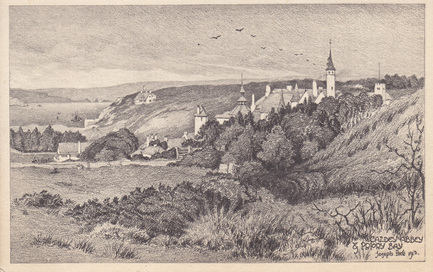 Caldey Abbey & Priory Bay
Caldey Abbey & Priory Bay
These images are from my set of a dozen postcards, and today’s blog post commemorates the event that took place on Caldey on this day in 1913.
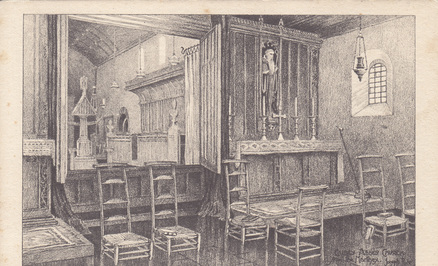 Caldey Abbey Church from the Narthex
Caldey Abbey Church from the Narthex
Executed with superb skill in pencil, they are the work of Joseph Pike (1883-1956), one of five brothers from an old Catholic family of Bristol. They were all educated at Ampleforth College, where Joseph studied art under William J. Boddy. While two of his younger brothers – Fr. Bertrand Pike 0.P. (1884-1954) and Fr. Alfred Pike, 0.P. (1887-1962) – went on to join the Order of Preachers (Dominicans), Joseph joined the studio of John Hardman & Co., manufacturers of stained glass, altars and other church furnishings.
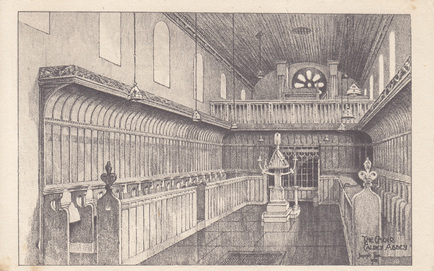 The Choir, Caldey Abbey
The Choir, Caldey Abbey
Pike’s interest in church interiors is evident from these pictures, as is his care in rendering precise details of architecture and metalwork. His great break came when he was asked by the Benedictine historian Bede Camm O.S.B. to provide illustrations for Forgotten Shrines (London: Macdonald & Evans, 1910). In his Preface, Father Bede wrote: ‘I feel a very special debt of gratitude to my artist, Mr Joseph Pike, for the very beautiful drawings with which he has illustrated and adorned the text. Mr Pike is still a young man, and there can be no doubt as to his great talent.’
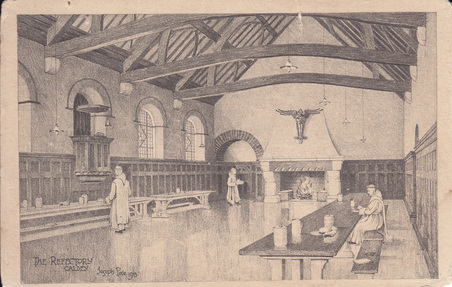
The Refectory, Caldey
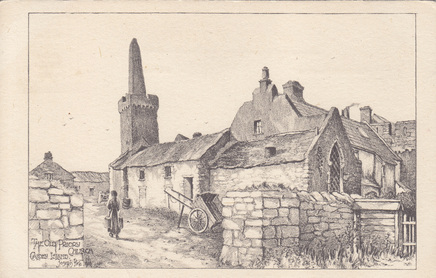 The Old Priory Church, Caldey Island
The Old Priory Church, Caldey Island
Caldey Island was at this time home to a community of Anglican monks under the leadership of Aelred Carlyle. I have written about this community elsewhere – there are references below under the Monk and His Movies blog post, and it is interesting to compare Peter Anson’s line drawings with Joseph Pike’s more nuanced depictions of textures and shading.
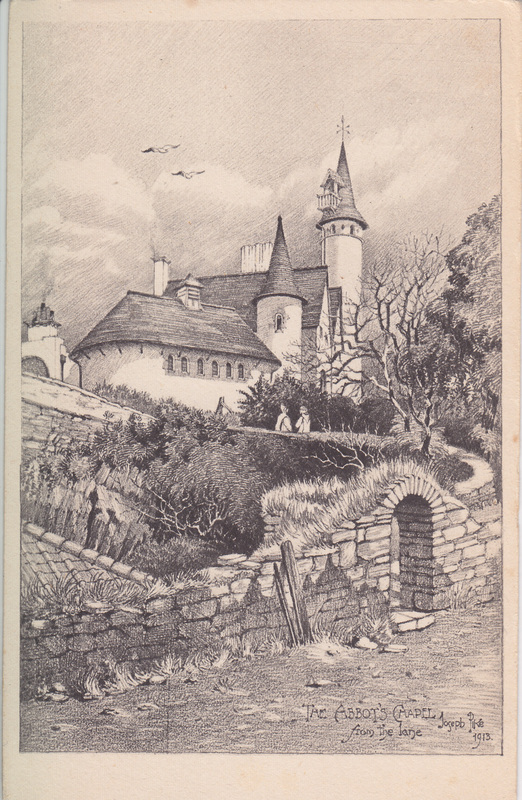
The Abbot’s Chapel, from the lane
Carlyle’s attempt to introduce Benedictine monastic life to the Church of England placed him and his community on a collision course with the Anglican authorities, particularly with regard to liturgical rites and ecclesiastical obedience. Matters eventually came to a head in 1913, resulting in almost the entire community being received into the Catholic Church. This took place 101 years ago today – 5th March 1913, the day before Joseph Pike’s thirtieth birthday.
Bede Camm had followed events on Caldey for some years, defending the community in a letter to the Catholic Times in 1905. He landed on the island on 28 February and said Mass in the monastery chapel – probably the first time this had been done since the Reformation. After the conversion, he became novice master to the monks. It was presumably through his involvement with the Caldey community that Joseph Pike visited the island to carry out these drawings.
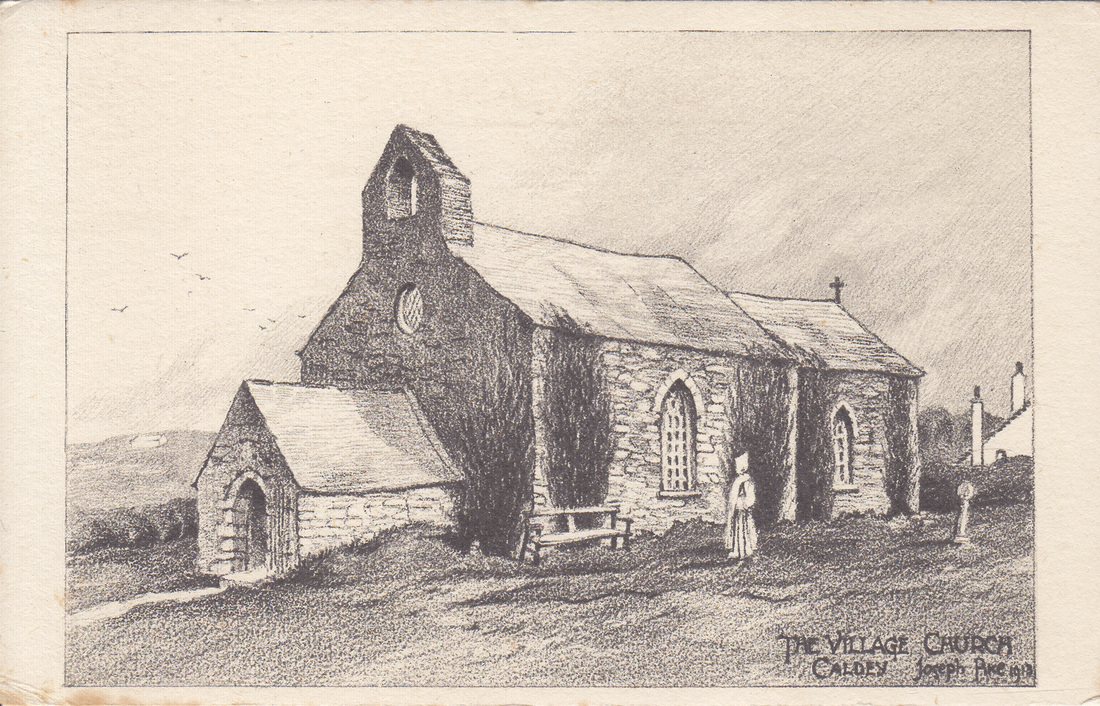
The Village Church, Caldey
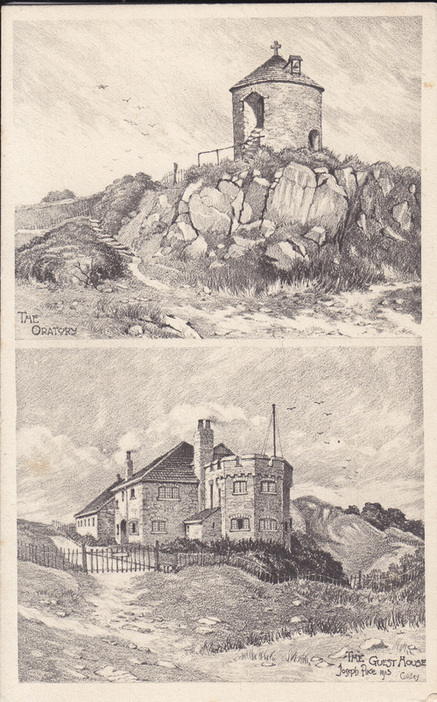 The Oratory (top), The Guest House (bottom), Caldey
The Oratory (top), The Guest House (bottom), Caldey
After the outbreak of the First World War, Pike left Hardman’s and joined the 7th Battalion, Royal Warwickshire Regiment, where he saw active service as a Lieutenant. He was badly injured in 1916 and invalided back to England where he spent some months convalescing at a sanatorium in Dartford.
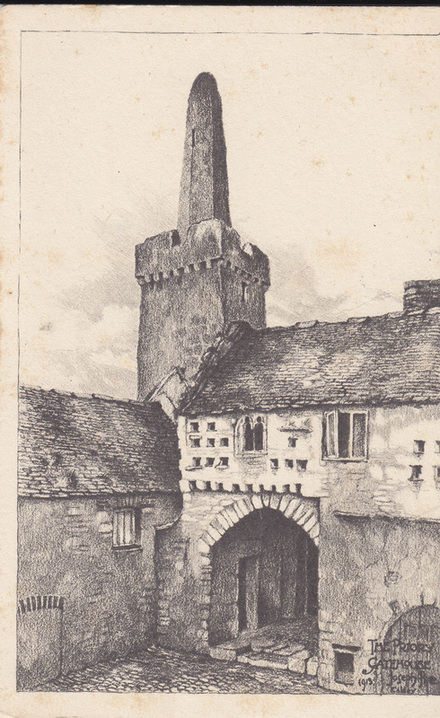 The Priory Gatehouse, Caldey
The Priory Gatehouse, Caldey
After the war Pike worked as a freelance artist, publishing a series of attractive little volumes: Chester: a sketch book (London: A. & C. Black, 1920), Ampleforth College: a sketch book (London: A. & C. Black, 1921), and Bruges: a sketch book (London: A. & C. Black, 1922), while his pencil drawings of London included locations such as St James’ Palace, Westminster, Marble Arch and the Artillery Memorial at Hyde Park Corner. The Roman Catholic Bishop of Southwark, John Butt, commissioned two drawings of St James’ Church, Spanish Place, and Pike also sketched St Edmund’s College, Ware, plus other scenes in Cardiff and Chepstow. He got married in the 1920s and had three children, a son and two daughters. He accompanied his brother Alfred to Lourdes in 1951, recording the pilgrimage with two fine studies of the Marian shrine which were reproduced as popular Christmas cards. He died in July 1956.
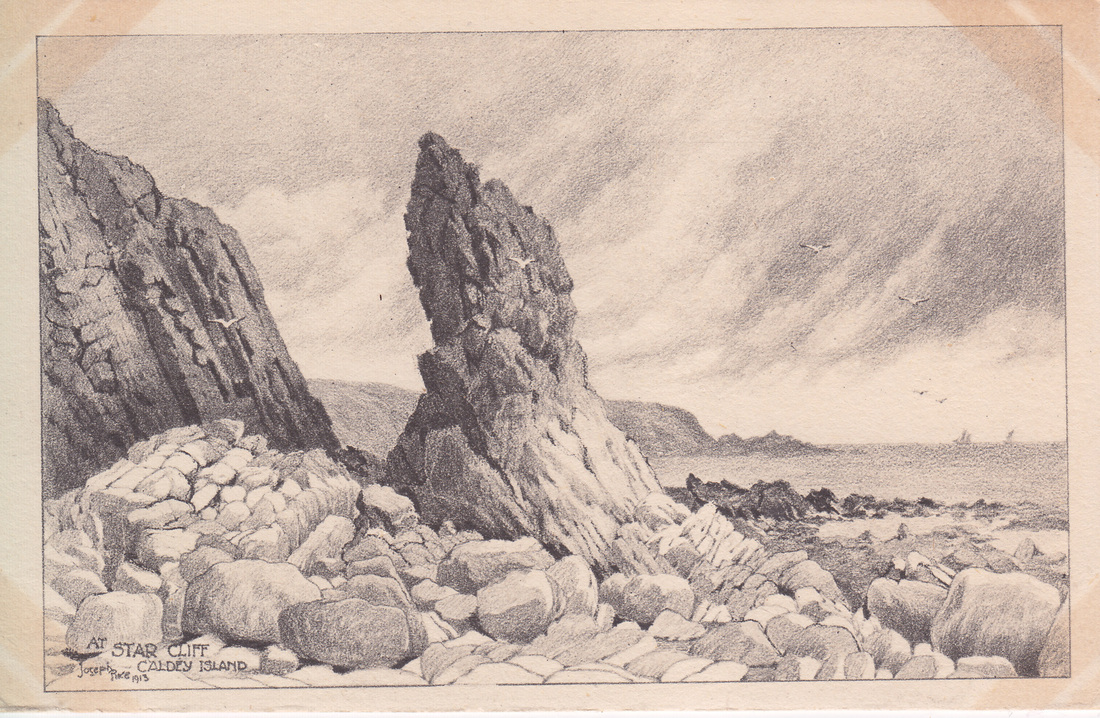
At Star Cliff, Caldey Island
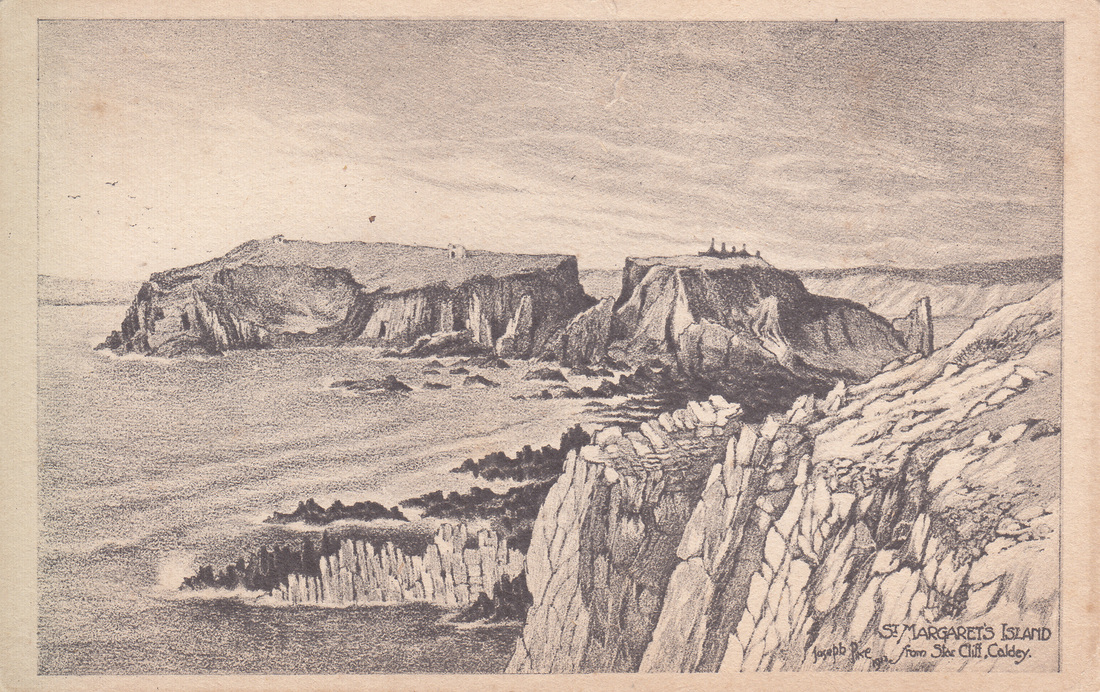
St Margaret’s Island,from Star Cliff, Caldey
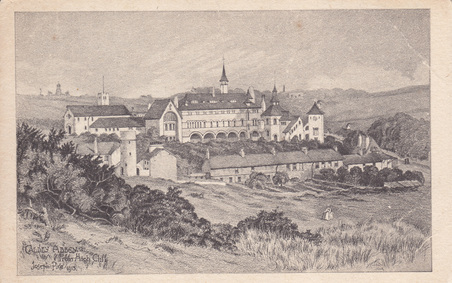
Caldey Abbey from High Cliff
 Caldey Abbey & Priory Bay
Caldey Abbey & Priory Bay Caldey Abbey Church from the Narthex
Caldey Abbey Church from the Narthex The Old Priory Church, Caldey Island
The Old Priory Church, Caldey Island The Oratory (top), The Guest House (bottom), Caldey
The Oratory (top), The Guest House (bottom), Caldey







found some old charcoal drawing at a thirft store Ripon Cathedral andFlamboro North Landing are they worth anything
Hi Sharlynn,
Thanks for your comment about the charcoal drawings you’ve found. It’s hard to say what they might be worth without seeing them, but two things to consider: a) are these original drawings, or reproduced prints? b) are they signed? An original, signed drawing would obviously be worth more than a reproduction, but sometimes it needs careful examination to distinguish the two. Regarding value, the old adage still stands – an item is only worth as much as buyers are willing to pay for it. There is a market for Joseph Pike artwork, but as with any artist, interest in him rises and falls, and there are other factors to consider such as the subject matter (a buyer in Ripon would probably be willing to pay more for the cathedral drawing than a buyer elsewhere) and the condition (even a small crease or torn corner can significantly reduce the value.) If making a profit from reselling seems not to be worthwhile, why not simply have them framed and hung at home where you can enjoy them? Anyway, I’m pleased to hear of your finds!
I have two signed engravings bu Joseph pike. Trada chipping Norton 0608 644325 of rugby Warwickshire .st. Andrew parish church AND theother the market
I have an original pencil drawing of ‘the old curiosity shop’ signed by Joseph Pike 1923. Is it worth anything?
Hi Ingrid, many thanks for your query. I’m afraid I can’t do much more than repeat what I wrote above in response to a similar question. Pike’s drawing of the Old Curiosity Shop is widely reproduced, and is also available in a colour version. Is yours actually drawn in pencil, or is it a print? Does it carry Pike’s actual, physical signature, or is it a stamped facsimile? Points like these make a significant difference regarding value.
I would be interested in buying this if you would like to sell it
Mr. Pike, I have an item for your consideration. I would be happy to email photographs if you provide your information. My email is jc11633@yahoo.Com and I am located in northern California, United States.
Thank you. Jane Coombs
I have two signed original JOESPH PIKE, IN PENCIL
I have recently come across an original pencil sketch by Joseph Pike entitled “A Quaint Corner is Warick” I cannot find any information about this particular sketch. I have checked it under magnification and can see actual pencil strokes!
Would love some information about it if possible. Thank you
Further to the comments above, including my own, I would like to clarify my comment that ‘there is a market for Joseph Pike artwork’. As I tried to explain, there is a difference between ‘originals’ and ‘prints’. Originals are the actual drawings that Joseph Pike sat down and drew on the actual paper. It is sometimes difficult to tell but experts will be able to examine the precise pencil lines and how hard Pike pressed the pencil into the paper, especially into the darker shades. I know the family are keen to get these back if they can, usually at a price of US$100-$200. ‘Prints’ are copies of the ‘originals’ which have been run off, often in large numbers uncle as on post cards. The signature will still be there as Pike signed all his work – but if the signature is simply reproduced as part of the printing process, although it helps to identify Pike as the artist, it certainly does not increase value. Recently, a large coloured Joseph Pike print came up for auction in England and the estimated sale value was £12-£15 (US$15-$18). I hope this helps gives readers of this blogpost a clearer idea about the potential value of their prints. Pike’s descendants are sometimes grateful for the opportunity to pick up bits and pieces but I am not aware of anyone else who is actively collecting his work. This is Pike not Pikasso!
I’m delighted to announce that my biography, ‘Joseph Pike: the happy Catholic artist’ is now available from Troubador Press and other outlets: http://www.troubador.co.uk/book_info.asp?bookid=4938
Pingback: Joseph Pike – Dark Lane Creative
Pingback: Caldey Postcard – New Order for an Old Postcard – Dark Lane Creative